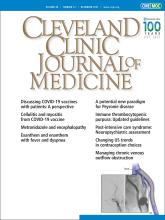ABSTRACT
Chronic venous outflow obstruction is a significant cause of chronic venous disease and therefore chronic morbidity. When conservative measures fail, intervention through deep venous reconstructive techniques should be considered. Referral should be considered in all patients with features of chronic venous disease that are life-affecting. Imaging relies primarily on duplex ultrasonography, supplemented by computed tomographic and magnetic resonance venography, and intraoperatively by intravascular ultrasonography. Intervention is primary endovenous, using angioplasty and stenting. Open surgical procedures are used in very select patients.
- Copyright © 2021 The Cleveland Clinic Foundation. All Rights Reserved.
- Matthew Harris, MBBS, MRCS
- Chung Sim Lim, MBBS, PhD, FRCS, FEBVS⇑
- Consultant Vascular and Endovascular Surgeon, Cleveland Clinic London and The Royal Free London NHS Foundation Trust, London, United Kingdom
- Address:
Chung Sim Lim, MBBS, PhD, FRCS, FEBVS, Consultant Vascular and Endovascular Surgeon, Cleveland Clinic London, 33 Grosvenor Pl, London SW1X 7HY, UK; chunglim{at}nhs.net
ABSTRACT
Chronic venous outflow obstruction is a significant cause of chronic venous disease and therefore chronic morbidity. When conservative measures fail, intervention through deep venous reconstructive techniques should be considered. Referral should be considered in all patients with features of chronic venous disease that are life-affecting. Imaging relies primarily on duplex ultrasonography, supplemented by computed tomographic and magnetic resonance venography, and intraoperatively by intravascular ultrasonography. Intervention is primary endovenous, using angioplasty and stenting. Open surgical procedures are used in very select patients.
- Copyright © 2021 The Cleveland Clinic Foundation. All Rights Reserved.






